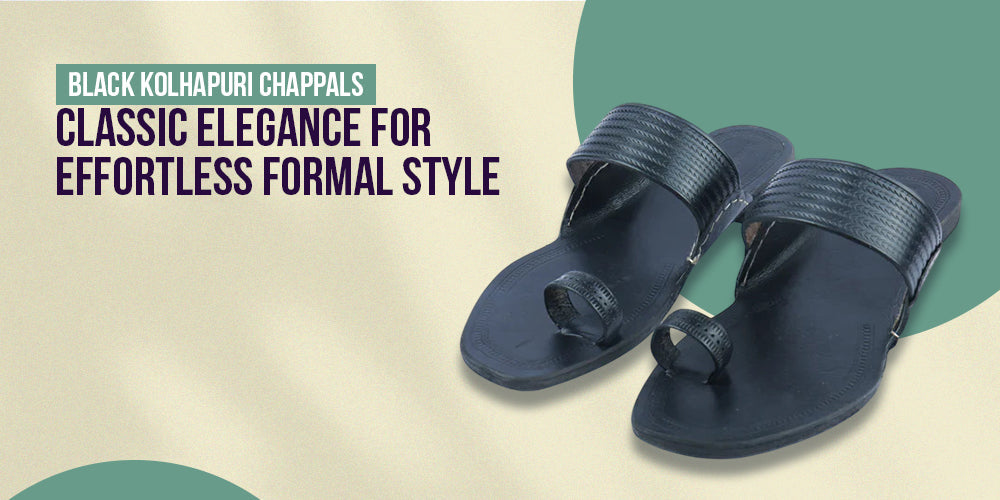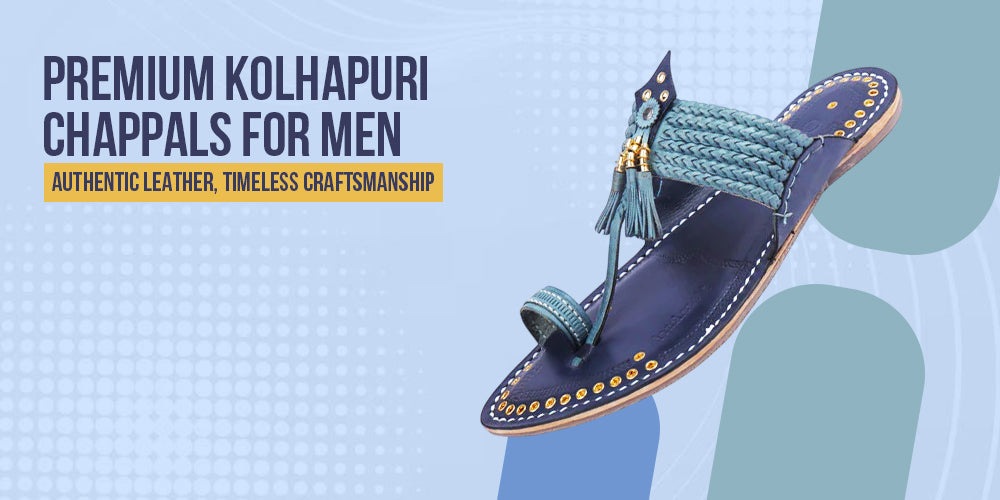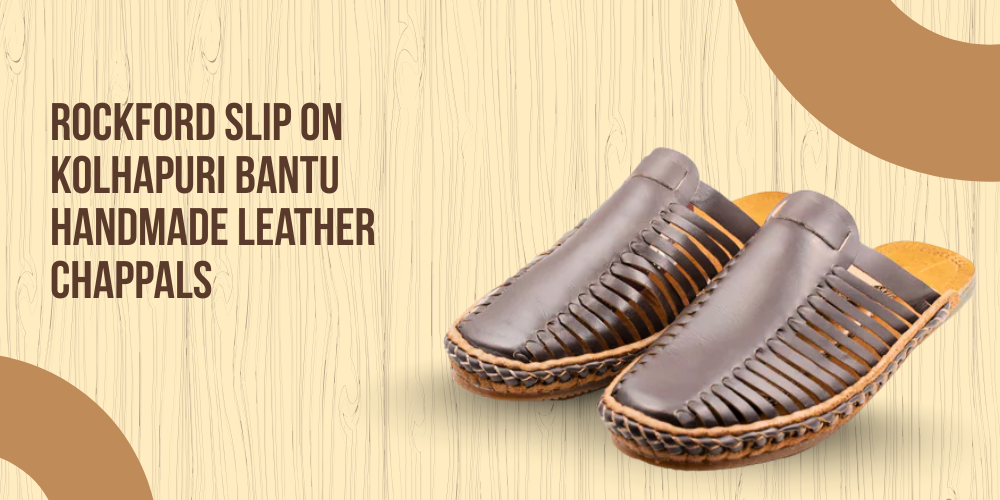In the ever-evolving world of fashion, where trends flicker like fireflies in the night, there's something profoundly reassuring about pieces that transcend time. Enter the Black Kolhapuri chappal—a masterpiece of Indian craftsmanship that effortlessly bridges the gap between ancient tradition and contemporary sophistication. If you've ever stood at the threshold of a formal event, pondering how to infuse your outfit with a touch of cultural depth without sacrificing style, these unassuming yet striking sandals might just be your secret weapon. Handcrafted in the sun-kissed soils of Maharashtra's Kolhapur district, the Black Kolhapuri chappal isn't just footwear; it's a statement of refined heritage, perfect for boardrooms, weddings, or black-tie galas. And at the heart of this revival? Korakari, a brand that's redefining what it means to step into formality with feet firmly rooted in tradition.
The Roots of Resilience: A Brief History of Kolhapuri Chappals
The story of Kolhapuri chappals is as layered as the leather from which they're born. Dating back to the 13th century, these sandals emerged from the fertile crescent of Maharashtra, where the Godavari River's bounty nourished both land and lore. Legend has it that the warrior king Shivaji Maharaj himself favored these sturdy yet supple footwears during his campaigns, valuing their durability on rugged terrains. Fast forward to the 20th century, and the craft evolved into a protected Geographical Indication (GI)-tagged treasure in 2019, ensuring that only those from the Kolhapur region can claim the authentic moniker.
What sets Kolhapuri chappals apart is their ingenious construction. Unlike mass-produced sneakers or glossy imports, these are born from the hands of skilled artisans—families who've passed down techniques like sacred scrolls. The leather, sourced from local tanneries, is treated with natural vegetable dyes, eschewing harsh chemicals for a process that's as eco-friendly as it is effective. The uppers are meticulously stitched using a saddle-stitch method, where threads of twisted cotton or leather weave through layers for unbreakable strength. And the soles? A marvel of simplicity: layered vegetable-tanned leather, beaten flat with wooden mallets until they're as flexible as a yogi's spine yet tough enough to withstand monsoons.
In black, this heritage takes on a formal finesse. The deep, inky hue—achieved through subtle, natural pigmentation—lends an air of gravitas. No flashy embellishments here; just clean lines that echo the Bauhaus principle of "less is more." It's this understated power that makes Black Kolhapuri chappals ideal for formal wear. They don't compete with your attire; they complement it, allowing the fabric's drape or the suit's cut to shine while grounding the look in authentic Indian ethos.
Guardians of the Craft in a Modern World
At the epicenter of this renaissance stands Korakari, a brand that's as much a custodian of culture as it is a curator of cool. Founded in 1973 by Shri Satappa Dhondiram More in the quaint village of Mhalunge, Kolhapur, what began as a modest venture producing genuine leather chappals has blossomed into India's premier destination for handcrafted footwear. More & Company, Korakari's parent entity, embodies the spirit of resilience: starting with a handful of artisans, it now employs hundreds, all dedicated to preserving the GI-tagged techniques that define Kolhapuri excellence.
What makes Korakari's Black Kolhapuri chappals stand out for formal wear? It's their alchemy of old and new. Take the materials: high-quality pure leather, softened to a buttery finish that caresses the skin without chafing. Beneath the heel, a discreet sponge layer adds cushioning for those long evening receptions, while the TPR (thermoplastic rubber) sole ensures grip on marble floors or rain-slicked patios—practicality wrapped in poetry. Eco-conscious to the core, Korakari dyes their leather with natural extracts, minimizing environmental footprint without compromising on that rich, velvety black.
Craftsmanship at Korakari is a labor of love, not a line on a factory conveyor. Each pair is hand-stitched by artisans who've honed their skills over generations, resulting in subtle variations that tell a story—much like the patina on a well-loved watch. For formal enthusiasts, this means a chappal that molds to your foot over time, becoming a second skin rather than a stiff intruder. And while specifics like pricing and sizing vary by collection (head to Korakari's site for the latest), their commitment to accessibility shines through: affordable luxury that doesn't skimp on quality.Customers rave about this blend. One reviewer gushed, "Great service, fast shipping, and very reasonable prices for products of such good quality! Korakari is highly recommended." Another echoed, "Lovely products. Great price and fast delivery. No hassle shopping. I will definitely be coming back." It's this grassroots acclaim that underscores Korakari's ethos: footwear that feels personal, not produced.
Why Black? The Psychology and Versatility of the Hue
Color theory isn't just for painters; in fashion, it's a silent communicator. Black, the absence of light yet the presence of all, symbolizes power, mystery, and elegance—qualities that align seamlessly with formal wear. In Indian contexts, where formal attire often dances between vibrant lehengas and somber sherwanis, black Kolhapuri chappals serve as a neutral anchor. They're the little black dress of footwear: endlessly adaptable.
Consider the spectrum of formal scenarios. For a corporate soiree, pair them with slim-fit trousers and a crisp white shirt; the chappals' open design keeps things airy, countering the suit's structure with subtle rebellion. Weddings? Slide into them under a bandhgala or an Anarkali, where the black contrasts beautifully with gold embroidery, adding depth without overwhelming. Even for cultural fusions—like a Indo-Western brunch—they ground high-street jeans with a blazer in effortless poise.
Versatility extends to gender fluidity too. While traditionally masculine, Korakari's designs flatter all: women's variants boast narrower straps for a feminine taper, men's wider bands for robust support. Unisex appeal is key in today's wardrobe, where boundaries blur. And let's not forget inclusivity—available in a range of sizes to accommodate diverse feet, ensuring everyone can partake in this formal foot-forward revolution.
Styling Secrets: How to Wear Black Kolhapuri Chappals with Flair
Styling formal wear is an art, and Black Kolhapuri chappals are your willing muse. Start with the basics: opt for slim silhouettes to elongate the leg line, avoiding baggy pants that drown the sandal's sleek profile. For men, a linen kurta-pajama in charcoal gray, cuffed at the ankles, lets the chappals peek out like a whispered invitation. Add a pocket square in emerald for a pop—nature's nod to Kolhapur's lush landscapes.
Women, rejoice: These chappals transform a simple black saree into high drama. Drape the silk low on the hips, letting the pallu cascade asymmetrically, and secure with a brooch for modernity. The black-on-black synergy creates a monochromatic magic, perfect for evening dos. Accessorize sparingly—a stack of silver bangles or a statement necklace—to keep the focus on movement, as the chappals' flexibility encourages graceful strides.
For mixed ensembles, think fusion: A midi skirt with a button-down shirt, finished with Kolhapuri chappals, bridges office-to-cocktail seamlessly. In monsoon season, their water-resistant leather (thanks to natural tanning) makes them a smart pick over soggy loafers. Pro tip: Polish them weekly with a leather conditioner to maintain that formal sheen—Korakari's pieces deserve the TLC.
Beyond the Boardroom: Everyday Luxury and Cultural Significance
Formal wear often conjures images of stiffness, but Black Kolhapuri chappals inject joy into the equation. Their lightweight build—often under 200 grams per pair—means you can dance at sangeets or negotiate deals without a second thought. Health-wise, the flat sole promotes natural posture, a boon for those plagued by heel woes. In a world grappling with fast fashion's toll, choosing Korakari supports ethical labor: fair wages for Kolhapur's weavers, preserving a craft at risk from mechanization.
Culturally, these chappals are more than accessories; they're ambassadors. Wearing them at international forums or diaspora events sparks conversations—"Where'd you get those?"—fostering pride in Indian ingenuity. In an era of globalization, they remind us that true style is sustainable, storied, and slightly subversive.
The Verdict: Step into Timeless Formal with Korakari
As we wrap this ode, it's clear: Black Kolhapuri chappals from Korakari aren't just for formal wear; they're for those who wear formality with flair. Rooted in 13th-century lore, elevated by 21st-century savvy, they offer comfort that doesn't compromise on class. Whether you're sealing a deal or sealing vows, these chappals ground you—literally and figuratively—in elegance.
Ready to lace up your legacy? Dive into Korakari's collection and discover how a simple step can redefine your stride. In the words of an artisan's hammer on leather: Strike while the iron's hot, or rather, while the dye's deep. Your formal future awaits, one authentic footprint at a time.




Leave a comment
This site is protected by hCaptcha and the hCaptcha Privacy Policy and Terms of Service apply.